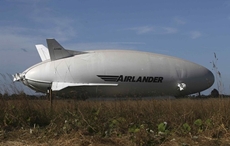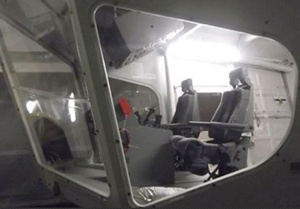Airship technology comes back to fore courtesy Airlander 10
19 Aug 2016
Above a field in the UK's rural Bedfordshire, a shiny, futuristic craft the size of a football pitch ascends majestically into the evening sky, and gawping onlookers crane their necks for a better view.
 This could be the stage for a new alien invasion film on the lines of Independence Day, but it is the maiden flight of the Airlander 10, a helium-filled craft aiming to kick-start a new age of the airship.
This could be the stage for a new alien invasion film on the lines of Independence Day, but it is the maiden flight of the Airlander 10, a helium-filled craft aiming to kick-start a new age of the airship.
It has been a while coming – the first flight had been delayed several times and Wednesday's takeoff was held up for hours – but once in the air, showing off its curves as it banks and soars for its audience, the Airlander is quite a spectacle.
At 92 metres long and 43.5 metres wide, this is the world's largest aircraft, dwarfing heavyweights such as the Airbus A380 ''superjumbo''. It is a fair bit cheaper, too, with a catalogue price of £25 million, compared with $375 million (£287 million) for an A380.
It can also carry a 10-tonne payload, comparable with military transport helicopters such as the Boeing CH-47 Chinook, the US Air Force's workhorse of choice.
The deep pockets of the world's biggest military power were pivotal in getting the Airlander off the ground. The US Air Force poured about $300 million into the project, envisaged as a battlefield surveillance mother ship capable of floating above conflict zones for 21 days at a time when unmanned. But when the US government slashed military budgets in 2013, the Airlander was among the casualties.
Hybrid Air Vehicles (HAV), the company behind the Airlander's development, gleefully bought back the lion's share of the airship, minus the top-secret military hardware. It had been paid nearly $100 million to build the craft and retrieved its creation for a mere $300,000.
Since then HAV has raised money through several rounds of crowd funding, and input from private investors. These include Peter Hambro, the mining magnate and scion of the Hambro banking dynasty, and Bruce Dickinson, the frontman of the heavy metal group Iron Maiden and a keen pilot.
HAV's chief executive, Stephen McGlennan, has his eye on a stock market listing toward the end of this year to raise up to £30 million. He believes there could be 100 of the airships in the skies within five years and says there is latent demand for around 1,000. Potential uses include tourist pleasure cruises, cargo transport and disaster relief.
The Airlander is already attracting interest from military powers willing to spend where the US was not. ''At first, 40 to 50 per cent of its use will be military,'' McGlennan predicts.
 The Airlander can stay airborne for weeks at a time, monitoring activity such as insurgents planting explosives. The craft may not be very subtle, but that's the point. ''You want them to see it,'' says McGlennan. ''It's about surveillance and keeping ground troops safe, but also about changing behaviours rather than catching people in the act.''
The Airlander can stay airborne for weeks at a time, monitoring activity such as insurgents planting explosives. The craft may not be very subtle, but that's the point. ''You want them to see it,'' says McGlennan. ''It's about surveillance and keeping ground troops safe, but also about changing behaviours rather than catching people in the act.''
It can fly out of reach of all but specialised ground-to-air weaponry, so militants taking pot shots shouldn't pose too many problems. ''It doesn't pop,'' says McLennan.
Unsurprisingly, references to airship disasters such as Hindenburg are strictly taboo at HAV. There is, however, no denying the historical link to a lesser-known tragedy. The cavernous hangars where the Airlander rests between flights once housed the ill-fated R101. At the time the world's largest aircraft, the R101 crashed on 5 October 1930, killing 48 of the 54 people on board along with any chance of a viable British airship industry.
The Airlander is immeasurably safer. It uses helium, an inert gas, rather than the hydrogen used by the R101 and the Hindenburg. Its hull is made from three layers of fabric, including Vectran, a material five times stronger than steel. HAV claims it can fly in high winds of up to 80 knots, the highest level on the Beaufort wind scale. It has a top speed of 100mph.
Robust and gigantic it may be, but the Airlander is also impressively graceful. With a maiden flight now safely navigated, it could be blotting out the skies over UK towns within a few years.






























